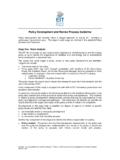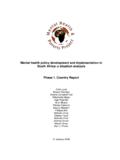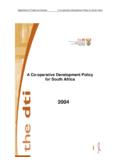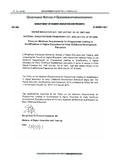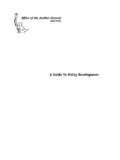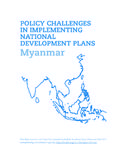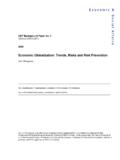Transcription of Policy Development and Review Process Guideline - EIT
1 W:\Data - \Policies and Procedures\EIT Policies and Procedures\ Policy Development and Review Process Policy Development and Review Process Guideline Policy Development will normally follow a staged approach to ensure EIT maintains a continuous improvement cycle. The steps in each stage are defined in the attached Policy Development Flowchart. Stage One: Needs Analysis The EIT will encourage an open and proactive approach to identifying issues and developing Policy so as to reduce the expenditure of needless time and energy due to amendments being developed in a piecemeal way. The issues that could trigger a Policy Review or new Policy Development are identified. Triggers can include: The Review date for the Policy , Policy gaps which may come through consultation with members of the Governance Board, the Academic Board, the Human Resources Manager, lecturers students or other stakeholders, or changes in the environment within or external to the EIT including: Legislative change Issues identified in the Policy issues log.
2 The Policy issues log should record issues that emerge through the implementation and the use of the policies of EIT. A key component of this stage is engagement with staff at EIT overseeing governance and academic administration. A submission should be made to the Governance Board or the Academic Board early in the Policy Development and Review Process to obtain their advice and assistance. This could be in relation to Policy Development , related policies, policies that may be superseded by a new Policy and legislation and approval pathways. The information the Boards can provide will help to determine the scope and impact of the Policy and the timeframe for completion. Developments at this stage help to establish the degree of urgency in relation to specific Policy issues and whether they need: an immediate Review or new Policy Development a later Review or Development , a mechanism other than the Policy Process Another key component of this stage is to identify the officers responsible for a Policy .
3 Policy contact: The person who has line-management responsibility for the Policy area and will guide the Development , implementation and Review of the Policy to ensure the content of the Policy is accurate and reflects current needs and practice. W:\Data - \Policies and Procedures\EIT Policies and Procedures\ Policy Development and Review Process Policy custodian: The executive who has overarching responsibility for identifying and setting the strategic direction of the proposed Policy and determining the overall context in which a Policy might be developed or revised. Their responsibility extends to how it is implemented and how it is monitored and reported. The Policy Custodian is the day-to-day contact in relation to Policy advice, that is, the position best suited to answer any questions on the application of the Policy .
4 The Policy contact will also play a major role in developing, implementing and reviewing Policy with other Policy stakeholders. In the context of the EIT, the Policy contact is generally the Accreditation Manager. It is necessary at this stage for the Policy custodian to obtain support for Policy Development . The need for a new Policy , or Policy Review could be identified at any level within the EIT. However, the overall context in which a Policy might be developed and reviewed should be done in consultation with the relevant management team members. Once the decision has been made to develop a new Policy or revise an existing Policy , the Policy custodian should take responsibility for its Development and implementation. If there is sufficient support for the Development or Review of a Policy , it may be necessary to assemble a team of stakeholders.
5 The makeup of such a team will depend on the particular Policy issue but it should always include representatives from groups that will use and be affected by the Policy . This will greatly improve the quality of the Policy and ensure it meets the needs of the EIT as a whole. It will also assist with the implementation Process because it promotes more buy-in and feedback from the critical parties. A Policy Development team may include: the Policy contact the Policy custodian staff that are expert in the subject matter students (where appropriate) Governance and Academic Board representative/s in some instances consultation with external organisations, experts in a specific field and/or critical stakeholders may be necessary to obtain information that helps to identify Policy gaps Stage Two: Research The Policy custodian will analyse any relevant information that could inform the Policy Development and Review as to whether a rule, Policy , procedure and/or Guideline is required and the degree to which it accords with EIT s strategic plan.
6 This may include but may not be limited to data analysis, literature Review and best practice. This analysis will help to identify whether legislative or other external regulations will impact on the Policy proposal. The Policy custodian will analyse the implications of the Policy Development and Review and consider how the proposed Policy will impact on other existing policies, stakeholders, administrative procedures and systems Development . This analysis will help to identify: stakeholders and mechanisms for consulting with stakeholders in later stages. In some instances it may be useful to consult with experts in the field and/or critical stakeholders at this stage when their input would be of assistance in drafting the Policy . W:\Data - \Policies and Procedures\EIT Policies and Procedures\ Policy Development and Review Process the scope of the implementation needs, the resources required for Policy implementation and the potential impact of the Policy on other policies and procedures.
7 Best practice guides and standards in industry and government as well as within the field of higher education. the appropriateness of preparing a discussion paper rather than immediately drafting a Policy document. Stage Three: Drafting The Policy contact will draft the new Policy or amend the existing Policy in consultation with stakeholders and in accordance with the Policy Framework of the EIT. The Policy template and the procedure template should be used for all EIT policies and procedures to maintain consistency and standardisation. Depending on the extent of change, urgency and timing of the Policy change, stakeholders should be consulted and have the opportunity to comment on the draft Policy . Changes that emerge from this consultation Process may indicate the need for further drafting of the Policy .
8 As well as drawing on the expertise and advice in Policy writing from the Governance and Academic Board, the Policy custodian should seek resources and training that are useful for Policy developers. Some recommended texts include: The Australian Policy Handbook (2007), 4th Edition, by Bridgeman, P and Davis, G (Allen & Unwin). It is considered an essential reference on the subject of Policy . Writing at Work Neil James, Allen & Unwin, 2007 Plain English at Work (produced for the Department of Education, Employment and Workplace Relations) Stage Four: Consultation The stakeholders identified in earlier stages of the Process need to be consulted with regard to the Development of the draft Policy and, where possible, those who participate in the consultative Process be invited to offer feedback.
9 It is also necessary to alert a wide range of EIT staff members of an upcoming Policy Development or Review Process . Early alerts sent, for example, by email can serve not only to advise staff about the Process but also to ask for feedback as to whether they consider they have an actual stake in it. EIT offers academic programs online to students both in Australia and overseas, which means it is extremely important to establish an effective framework for consultation. Ongoing Review and improvement of policies and outcomes will be an essential basis for building strong relationships both within and outside the EIT. Depending on potential constraints arising with regard to Policy issues, it may not always be possible to consult with all stakeholder groups but, when this arises, such constraints should be made clear.
10 The Policy custodian or delegate should consider placing the draft Policy or draft principles of the Policy on the agenda of relevant meetings such as committee meetings to ensure that the Policy reflects the needs of the entire EIT. Consideration should be given to consulting W:\Data - \Policies and Procedures\EIT Policies and Procedures\ Policy Development and Review Process with committees simultaneously rather than consecutively if this would reduce the timeframe for Policy Development and Review . The role that committees play in Policy Development can shift in focus to be more strategic by examining the key principles in a particular Policy area as opposed to proofing Policy documents. Consideration should also be given to consulting beyond the committee framework. Besides Policy forums, focus groups and workshops, email provides a very effective vehicle for engaging either a wide or a select group of stakeholders about Policy issues.
